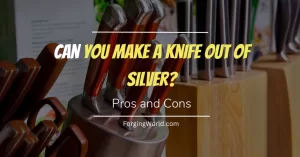Today, we’re going to dive into the question that’s been on everyone’s mind: Is leaf spring good for knife making?
You may have heard of people using leaf springs to craft beautiful knives, but is this just an urban legend, or can you actually create high-quality blades from these seemingly ordinary car parts?
Buckle up, because we’re about to explore the pros and cons of using leaf springs in your knife-making journey!
Is Leaf Spring Good for Knife Making?
Leaf springs are commonly found in the suspension system of many vehicles. They’re made from tough, durable steel that’s designed to handle heavy loads and constant stress. This makes them a prime candidate for knife making.
But are they really worth the effort? Let’s find out.
Pros of Using Leaf Springs to Make Knives
Availability and Affordability: A Cost-Effective Solution
Leaf springs are relatively easy to come by, either from scrapyards or old vehicles. They’re usually cheaper than buying new steel, making them an appealing option for budget-conscious knife makers.
By repurposing these discarded materials, you can create high-quality knives without breaking the bank.
High Carbon Steel: Excellent Hardness and Edge Retention
One of the key factors in a knife’s performance is its steel composition. Leaf springs are typically made from high-carbon steel, which is known for its hardness, durability, and ability to hold an edge.
High carbon steel is a popular choice among knife makers, as it offers a good balance of performance and ease of sharpening.
Eco-Friendly: Promoting Sustainability in Knife Making
By using leaf springs for your knife-making projects, you’re actively contributing to a more sustainable and eco-friendly practice.
Repurposing these materials helps reduce waste and promote recycling, which benefits both the environment and your local community.
Unique Character: Crafting One-of-a-Kind Blades
When you use leaf springs as your knife material, you’re not only creating a functional tool but also a unique piece of art.
Each leaf spring has its own history and character, which translates into the finished blade.
This individuality can be a selling point, especially if you’re considering making custom knives for collectors or enthusiasts.
Versatility: Suitable for Various Knife Styles and Designs
Leaf springs come in different sizes and shapes, which can be adapted to create a wide range of knife styles and designs.
This versatility allows you to experiment with different types of knives, from hunting and kitchen knives to specialized blades like straight razors.
Cons of Using Leaf Springs to Make Knives
Inconsistent Quality: Potential Variability in Material Performance
The quality of leaf springs can vary greatly, depending on factors like the vehicle’s age and how it was used.
This variability can lead to inconsistencies in the performance and durability of the knives you create.
To mitigate this issue, it’s essential to test the steel before using it in your knife-making project.
Unknown Alloy Composition: Challenges in Heat Treating
The exact alloy composition of a leaf spring can be hard to determine, which may affect the heat-treating process.
Proper heat treatment is crucial for achieving the desired hardness and durability in a knife, so working with an unknown alloy can be a challenge, especially for beginners.
Extra Work: Additional Preparation and Processing
Leaf springs require more work to process into usable material for knife making, such as cleaning, cutting, and straightening.
This extra effort can be time-consuming and may require specialized tools or equipment, which could increase the overall cost of your project.
Potential Safety Hazards: Ensuring a Safe Knife-Making Experience
Working with leaf springs can pose some safety risks, particularly when cutting and shaping the material. Sharp edges, flying debris, and hot surfaces can lead to injuries if not handled properly.
It’s essential to be aware of these hazards and follow proper safety precautions to ensure a safe and enjoyable knife making experience.
Limited Material Thickness: Potential Limitations in Design
Leaf springs are designed to be thin and flexible, which may limit the types of knives you can create. For example, if you’re interested in making thicker, heavy-duty blades, leaf springs might not be the ideal material.
You’ll need to consider the specific requirements of your knife design and evaluate whether leaf springs can meet those needs.
Tips for Making Knives from Leaf Springs
If you’re ready to take on the challenge of using leaf springs for your next knife project, here are some practical tips to help you out:
Find a Reliable Source: Try to find a consistent source of leaf springs, like a local scrapyard, to ensure that you have a steady supply of material for your projects.
Clean and Inspect: Before working with a leaf spring, make sure it’s clean and free of rust, dirt, and grease. Inspect it for any cracks or defects that may cause problems during the forging process.
Choose the Right Tools: Having the right tools will make your knife making journey much smoother. Invest in quality equipment to help you shape, heat treat, and finish your leaf spring knives.
Learn from Others: Connect with fellow knife makers who have experience working with leaf springs. They can offer valuable insights, advice, and even common mistakes to avoid.
Frequently Asked Questions
How do I clean and prepare a leaf spring for knife making?
Start by removing any dirt, rust, and grease using a wire brush or an angle grinder with a wire wheel attachment. Inspect the leaf spring for any cracks or defects that may cause issues during the forging process. Finally, cut the leaf spring into manageable pieces using an angle grinder, metal cutting bandsaw, or plasma cutter.
How can I straighten a leaf spring for knife making?
Heat the leaf spring in your forge until it’s glowing red, then use a hammer and an anvil to straighten it. Work slowly and methodically, making sure to maintain even heat throughout the entire length of the spring. Quench the straightened piece in water or oil, depending on the type of steel, to cool it down.
Can I heat treat a leaf spring knife using the same process as other high carbon steels?
While the process might be similar, the unknown alloy composition of a leaf spring can make heat treating more challenging. It’s crucial to perform some tests on the material to determine its specific heat-treating requirements. You can also seek advice from experienced knife makers who have worked with leaf springs before.
Are there specific types of leaf springs that are better for knife making?
Leaf springs made from high carbon steel, such as 5160 or 9260, are generally considered better for knife making due to their hardness, durability, and edge retention. However, the exact alloy composition can vary, so it’s essential to test the material before using it in your project.
How do I sharpen and maintain a leaf spring knife?
Sharpening a leaf spring knife is similar to sharpening any other high carbon steel knife. You can use a whetstone, diamond stone, or even sandpaper to sharpen the blade. To maintain your knife, clean and dry it after each use, and apply a thin layer of oil to protect it from rust and corrosion. Regularly inspect the blade for any signs of wear or damage, and address any issues as needed.
Final Thoughts
Using leaf springs for knife making can be a rewarding and cost-effective way to create unique, high-quality knives. While there are some challenges associated with working with this material, such as inconsistent quality and the need for additional preparation, the benefits of affordability, sustainability, and versatility often outweigh these drawbacks.
As with any knife making project, the key to success lies in your dedication to learning, experimentation, and honing your skills. By connecting with fellow knife makers, seeking advice, and carefully testing and preparing your materials, you can turn leaf springs into exceptional blades that are both functional and artistic.
So, if you’re up for the challenge and eager to create one-of-a-kind knives, give leaf spring knife making a try. With patience, practice, and a little creativity, you’ll be well on your way to crafting impressive knives that showcase the beauty of repurposed materials.



